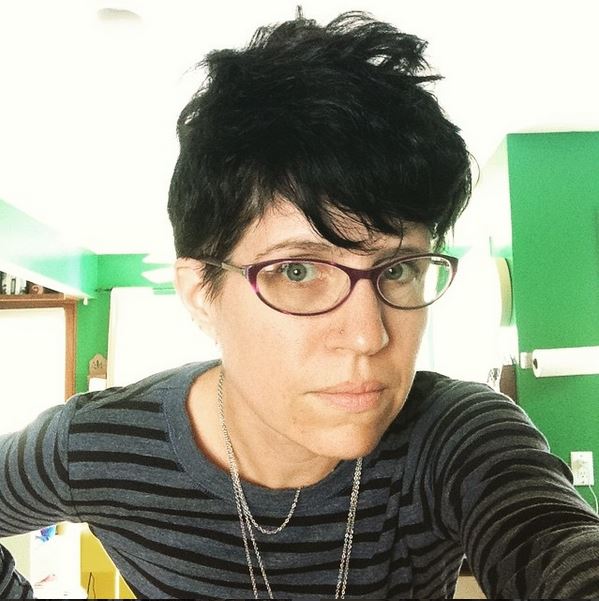
Her essay, "Lanes," appeared in Issue Ninety-Six of The Collagist.
Here, Kristine Langley Mahler talks with interviewer William Hoffacker about erasures, our impressions of the truth, and the rules of being a teenage girl.
What can you say about the origins of your erasure piece “Lanes”? How did you first encounter the original text? What inspired you to create this erasure?
“Lanes” is an erasure essay from a book-length erasure project I’m (still) in the process of completing, which started with an old thrift store copy of The Seventeen Book of Etiquette and Entertaining from 1963. I’d always loved the pomp and circumstance of social behavior from the decades before my casual youth in the 90s, and as I read through the guide, I kept encountering so many directives to the reader which offended my sensibilities. I didn’t want to ruin the book—a document of a foregone era—but I had to do something, so I made a photocopy of the book and started removing parts of the text to make the chapters read like what I believed I was really being instructed to do; how I had interpreted the rules of being a teenage girl.
In the process of erasing the chapters, I’m creating a narrative where the sentences are pushing back and illuminating my experience, not agreeing with the “any girl can get a date if you just do _____” bullshit promises of the guide (and the magazines of that era)—those weren’t representative of my adolescence.
Please describe the process of how you composed this erasure. Did you work by hand, or on a computer, or both? Was there a specific intention behind the choices of what language to erase, or was it more improvisational?
I generally erase by hand, but I circle the words/letters I want to keep rather than blacking out the parts I am not using because when it comes to revision, I’m always grateful when I can still see what I removed. I learned this the hard way on a few chapters! Once the chapter is complete, I type it up and begin to edit, though I usually have a pretty light hand—just looking for clarity—because I’ve already removed so much.
For me, creating an erasure is a delicate balance between improvisation and intention. It’s probably important to note that, somewhere along the line, I switched toward using less of the direct text and, instead, creating new words from the text. The word creation still follows the rules of erasure (must remain in original order with nothing added), but has allowed a new lyricism to filter through.
It’s a somewhat mystical process—I can’t describe how I know what words I want to keep and which to remove. I read through a chapter once or twice before beginning the erasure, and sometimes I erase the title first, which helps dictate what I plan to look for in the piece. But mostly, I go with my gut and keep the phrases or words that jump out at me.
Your bio states you are “a memoirist experimenting with the truth.” Can you elaborate on that—how you experiment with the truth and what that means to you? (Is erasure a form of experiment that you practice often? If so, would you tell us a little about why you are drawn to erasure?)
Nonfiction is constantly maligned over readers’ skepticism that its authors cannot possibly be telling The Truth. There’s a presumption that a single, unvarnished, empirical truth exists, and I’m not stepping on any Alternative Facts when I say that in the subgenre of memoir, feelings and emotions can color our impressions of the truth. I can take a relationship from my past and describe it as I knew it at the time; I can take that same relationship and describe it with the knowledge I have now; I can take that relationship a third time and describe it as I wanted it to be; I can take that relationship again and describe it the way my best friend tells me she remembers it, and on and on into infinity. All of those impressions illuminate different facets of the unalterable facts.
To experiment with the truth is to allow experience to constantly re-filter information which had once seemed static. Erasure essays, for me, are performances of those re-filtered truths. I’m drawn to uncertainty and recalibration, both in my erasures and my essays, as evidence of our capacity for growth.
What writing project(s) are you working on now?
I’m still completing the full book-length erasure of the Seventeen guide, though the end is in sight. I’m also sorting through research I’ve gathered towards a project on the privilege of home, examining immigration and my family’s four-hundred-year occupation on native land. I’ve pored through both revisionist and traditional accounts of Canadian history; traveled to Québec, Wisconsin, and Minnesota to understand the places my ancestors have called home; and spent a year transcribing eighteen years of my great-grandfather’s diaries into 500+ pages of primary source documents. I expect I’ll be confronting the specter of “home” and all its promises for quite some time.
What have you read recently that you would like to recommend?
Two recent essay collections which blew me away were Jessie van Eerden’s The Long Weeping and Erica Trabold’s forthcoming Five Plots, which I was fortunate to receive as an ARC. Their circuitous routes around memory, home, and truth are fascinating and inspiring.
